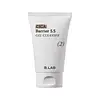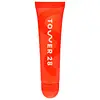What's inside
What's inside
 Key Ingredients
Key Ingredients

 Benefits
Benefits

 Concerns
Concerns

 Ingredients Side-by-side
Ingredients Side-by-side

Water
Skin ConditioningGlycerin
HumectantCoco-Betaine
CleansingMethyl Gluceth-20
HumectantCentella Asiatica Leaf Water
Skin ConditioningDipropylene Glycol
HumectantXanthan Gum
EmulsifyingSodium Chloride
MaskingMethylpropanediol
SolventPanthenol
Skin ConditioningHydroxyacetophenone
AntioxidantSodium Cocoyl Isethionate
Cleansing1,2-Hexanediol
Skin ConditioningCitric Acid
BufferingMalt Extract
Skin ProtectingDisodium EDTA
Ethylhexylglycerin
Skin ConditioningHydrogenated Polyisobutene
EmollientPolybutene
Diisostearyl Malate
EmollientHydrogenated Soybean Oil
EmollientHydrogenated Olive Oil
Skin ConditioningPolyhydroxystearic Acid
EmulsifyingHydrogenated Jojoba Oil
AbrasiveEthylene/Propylene/Styrene Copolymer
Copernicia Cerifera Wax
Euphorbia Cerifera Wax
Lauroyl Lysine
Skin ConditioningButyrospermum Parkii Butter
Skin ConditioningRicinus Communis Seed Oil
MaskingCaprylyl Glycol
EmollientTocopherol
AntioxidantEthylhexylglycerin
Skin ConditioningPhytosterols
Skin ConditioningTocopheryl Acetate
AntioxidantButylene/Ethylene/Styrene Copolymer
Simmondsia Chinensis Seed Oil
EmollientGlycine Soja Oil
EmollientCocos Nucifera Oil
MaskingPentaerythrityl Tetra-Di-T-Butyl Hydroxyhydrocinnamate
AntioxidantAroma
Benzyl Alcohol
PerfumingBenzyl Benzoate
AntimicrobialIron Oxides
CI 15850
Cosmetic ColorantHydrogenated Polyisobutene, Polybutene, Diisostearyl Malate, Hydrogenated Soybean Oil, Hydrogenated Olive Oil, Polyhydroxystearic Acid, Hydrogenated Jojoba Oil, Ethylene/Propylene/Styrene Copolymer, Copernicia Cerifera Wax, Euphorbia Cerifera Wax, Lauroyl Lysine, Butyrospermum Parkii Butter, Ricinus Communis Seed Oil, Caprylyl Glycol, Tocopherol, Ethylhexylglycerin, Phytosterols, Tocopheryl Acetate, Butylene/Ethylene/Styrene Copolymer, Simmondsia Chinensis Seed Oil, Glycine Soja Oil, Cocos Nucifera Oil, Pentaerythrityl Tetra-Di-T-Butyl Hydroxyhydrocinnamate, Aroma, Benzyl Alcohol, Benzyl Benzoate, Iron Oxides, CI 15850
 Reviews
Reviews

Ingredients Explained
These ingredients are found in both products.
Ingredients higher up in an ingredient list are typically present in a larger amount.
Ethylhexylglycerin (we can't pronounce this either) is commonly used as a preservative and skin softener. It is derived from glyceryl.
You might see Ethylhexylglycerin often paired with other preservatives such as phenoxyethanol. Ethylhexylglycerin has been found to increase the effectiveness of these other preservatives.